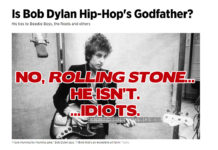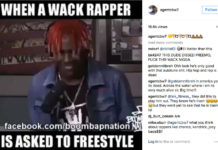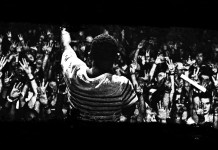During the 2003 Iraq war, the practice of “embedded reporters” rose to the forefront of American journalism, providing the viewing public with footage delivered literally from the frontlines of combat. Reporting from this unique vantage point proved to be the ultimate reality show, and while some criticism was noted regarding the almost impossible task of remaining objective, the end result was that the world was able to witness a monumental occurrence from a perspective that was never previously available.
Documenting the rise, and subsequent fall, of an undeniably groundbreaking music group may not compare with the Gulf War in terms of overall historical value to humankind, but it is this kind of unfettered access during the 15 years since their ascension to near-godlike hip-hop status that equipped Gerald “Gee Bee” Barclay with the materials to craft the viewed-from-behind-the-scenes, embedded-reporter-meets-Behind-The-Music documentary, Wu: The Story of the Wu-Tang Clan.
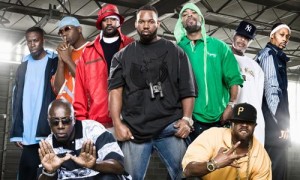 A long time Wu cameraman and video director, Barclay accompanied the fabled hip-hop crew for years, collecting an archive of audiovisual material from the earliest days of their formation. Weaving this collection into an approximately 80-minute documentary proved understandably challenging to Barclay, whose previous film achievements include Liberia: The Love of Liberty Brought Us Here, a personal and engagingly revealing look at the chaotic existence of Barclay’s homeland. “When you’re laying something out in a 90 minute, 2-hour time frame,” Barclay admits, “It’s almost impossible to be able to pay attention to all of the details.”
A long time Wu cameraman and video director, Barclay accompanied the fabled hip-hop crew for years, collecting an archive of audiovisual material from the earliest days of their formation. Weaving this collection into an approximately 80-minute documentary proved understandably challenging to Barclay, whose previous film achievements include Liberia: The Love of Liberty Brought Us Here, a personal and engagingly revealing look at the chaotic existence of Barclay’s homeland. “When you’re laying something out in a 90 minute, 2-hour time frame,” Barclay admits, “It’s almost impossible to be able to pay attention to all of the details.”
Despite the complexities of having to comb through archives, conduct and review interviews, and tell the story with as much journalistic integrity as possible, there was the added difficulty of assembling an “authorized” story, one that had to be cleared by many formidable personalities. After all, these individuals, despite a familial musical camaraderie, were as much known for explosive differences as they were for their cohesive unity. “If you know Wu-Tang like I know Wu-Tang, you know they’ve never been all on the same page,” Barclay, who directed early Wu videos for M.E.T.H.O.D. Man, and Da Mystery of Chessboxin’, explains, “But it’s sort of this love-hate relationship that I have with Wu-Tang. I’ve never in my whole life been able to please all of them. So I know for a fact that I can’t even waste my time trying to. I have to be headstrong and selfish in a way, to get a point across, to be able to see my vision from a filmmaker position. That’s what I ended up doing.”
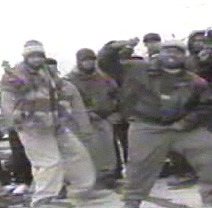 His vision plays out much like an E! True Hip-Hop Story would, with the twist of actually having been present during the time this story was being written, all of which delivers the audience a documentary that feels rather raw, which in turn ties in well to the rugged Wu-Tang aura. Barclay states that while the total amount of actual exclusive footage he compiled over the years was not necessarily massive in of itself, it was “the right footage”, and indeed, the never-before-seen scenes were, at times, quite riveting.
His vision plays out much like an E! True Hip-Hop Story would, with the twist of actually having been present during the time this story was being written, all of which delivers the audience a documentary that feels rather raw, which in turn ties in well to the rugged Wu-Tang aura. Barclay states that while the total amount of actual exclusive footage he compiled over the years was not necessarily massive in of itself, it was “the right footage”, and indeed, the never-before-seen scenes were, at times, quite riveting.
Of particular interest was the section dealing with the self-destruction, and subsequent attempt at self-resurrection, of Ol’ Dirty Bastard, the sometimes-irreverent, often-newsworthy group member whose ultimate demise stunned, though perhaps didn’t surprise, the hip-hop world. A good portion of the film was spent on this singular member and the tumultuous course of events which created his legacy within a legacy. “I asked ODB when he came out of prison, ‘What are you thinking?’” Barclay recalls, remembering the period of time when ODB seemed like he could conceivably rise above the demons which had plagued him for so long. “He was basically ready to get back and do it. All the other interviews around that event showed how optimistic all those people were about what was going to happen in the next few months, to spark the brand… Get everything back on again. The fact that it didn’t… I felt like this was Shakespeare…” he trailed off, pausing before continuing. “I had to document that.”
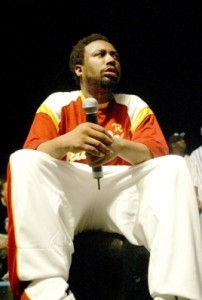 Barclay recalled witnessing the music network VH1 shooting, but then never showing, footage from one of ODB’s final public appearances before his death. Believing that ODB’s fate had an enormously influential effect on the Wu dynasty, Barclay felt this was a disservice that he was compelled, and uniquely qualified, to correct. “I felt, here’s an opportunity to see the real guy, and they just cut it out altogether. It’s very important to say who will tell your story. That’s why in my narration in the beginning of the movie, I said ‘You know what, I know some people may be angry’, but the bottom line is, I felt it was my duty. Now, they realize, this guy may have seemed like he was selfish for not turning stuff over to us, or not paying attention and doing it the way each person wanted to do it, it actually worked out fine. Because at the end of the day, I was able to bring this stuff back home. So I was thrust into that circle, maybe for a reason, because when I go online and read what people are writing, how that Wu-Tang base has been reignited again… I felt that was positive.” Indeed, Barclay hints that since the movie first debuted, winning a “Best Documentary” award at the Hip-Hop Odyssey Film Festival, and its subsequent airing on BET, certain remaining factional divides under the Wu roof may have begun to heal, and that his cinematic endeavor may have delivered this unintended, but welcomed, result.
Barclay recalled witnessing the music network VH1 shooting, but then never showing, footage from one of ODB’s final public appearances before his death. Believing that ODB’s fate had an enormously influential effect on the Wu dynasty, Barclay felt this was a disservice that he was compelled, and uniquely qualified, to correct. “I felt, here’s an opportunity to see the real guy, and they just cut it out altogether. It’s very important to say who will tell your story. That’s why in my narration in the beginning of the movie, I said ‘You know what, I know some people may be angry’, but the bottom line is, I felt it was my duty. Now, they realize, this guy may have seemed like he was selfish for not turning stuff over to us, or not paying attention and doing it the way each person wanted to do it, it actually worked out fine. Because at the end of the day, I was able to bring this stuff back home. So I was thrust into that circle, maybe for a reason, because when I go online and read what people are writing, how that Wu-Tang base has been reignited again… I felt that was positive.” Indeed, Barclay hints that since the movie first debuted, winning a “Best Documentary” award at the Hip-Hop Odyssey Film Festival, and its subsequent airing on BET, certain remaining factional divides under the Wu roof may have begun to heal, and that his cinematic endeavor may have delivered this unintended, but welcomed, result.
It was this kind of careful consideration, balancing journalism and objectivity with closeness and extreme access, which allowed Barclay to make a movie that, for the most part, satisfied two very differing goals: Provide enough specificity and inside information, exclusive footage and new interviews to satisfy the knowledgeable and passionate Wu-Tang fan base, and provide an overarching view and elementarily educational expose of an arguably unparalleled story in music history. Criticism has suggested that attempting to satisfy both of these missions, left both perspectives somewhat unfulfilled. However, Barclay’s task was of an extraordinary nature. Piecing together and revealing exclusive nuggets from the recorded memoirs of such a publicly adored group in of itself is no easy feat.
Consider too, that his embedded nature surely exposed him to potentially incendiary dirty laundry that could have threatened the film’s “authorized” status. One must conclude that there is probably information that to this day remains under wraps, the directorial equivalent of having to keep certain things “off the record”. Add to the mix the likely corporate tweaking necessary to bring the project to the BET airwaves, and one can begin to imagine the roadblocks that Barclay surely had to navigate. Despite what might be missing, it is fairly easy to respect the final outcome for its authenticity, raw perspective and reflective look at one of the most elaborate and enigmatic forces in entertainment history.
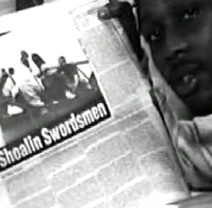 Being a fly on the wall during the peak of the Wu dynasty provided Barclay a truly one-of-a-kind viewpoint, allowing him to witness a once-in-a-generation force in American popular music history. Crediting a perfect storm of events and personalities for the formation of the Wu-Tang Clan, Barclay does remain humbled by his proximity to such an improbable, almost unimaginable trip through entertainment history. “I think it was best said by Remedy in the film,” Barclay reflects when asked if a Wu-like phenomenon could ever be repeated. “He said, ‘It was new then, it will never be exactly as it is’, because all these people have already seen it. No one had ever seen it before when it happened in ’93. Anyone would just be copying, so it wouldn’t be as authentic. Never will you get a group of nine emcees, and maybe six of them, or five of them are the most prolific forces in hip-hop, lyrically or creatively.” He finishes, almost sadly, “So, no. I don’t think you’ll ever see that happen again.”
Being a fly on the wall during the peak of the Wu dynasty provided Barclay a truly one-of-a-kind viewpoint, allowing him to witness a once-in-a-generation force in American popular music history. Crediting a perfect storm of events and personalities for the formation of the Wu-Tang Clan, Barclay does remain humbled by his proximity to such an improbable, almost unimaginable trip through entertainment history. “I think it was best said by Remedy in the film,” Barclay reflects when asked if a Wu-like phenomenon could ever be repeated. “He said, ‘It was new then, it will never be exactly as it is’, because all these people have already seen it. No one had ever seen it before when it happened in ’93. Anyone would just be copying, so it wouldn’t be as authentic. Never will you get a group of nine emcees, and maybe six of them, or five of them are the most prolific forces in hip-hop, lyrically or creatively.” He finishes, almost sadly, “So, no. I don’t think you’ll ever see that happen again.”
Luckily for us, Gee Bee was there when it did.
Wu: The Story of the Wu-Tang Clan, and the accompanying CD can be purchased through Amazon.com.
Update: Chicago Tribune, 12/12/08, Raekwon and the Wu-Tang Clan are bringing the classics
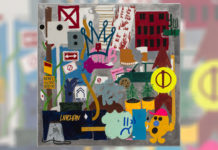
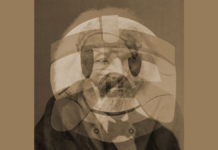
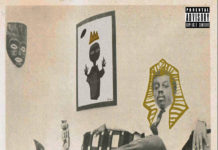
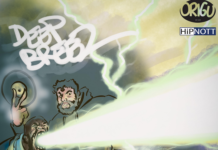

![The Underachievers – Crescendo [VIDEO]](https://www.birthplacemag.com/wp-content/uploads/2017/08/hqdefault-2-218x150.jpg)


![Fat Joe & Remy Ma ft. The-Dream – Heartbreak [VIDEO] Fat Joe Remy Ma The Dream - Heartbreak Video](https://www.birthplacemag.com/wp-content/uploads/2017/05/fat-joe-remy-ma-218x150.jpg)
![JSWISS featuring Chandanie – LML [VIDEO] JSWISS featuring Chandanie - LML [VIDEO]](https://www.birthplacemag.com/wp-content/uploads/2017/05/JSWISS-218x150.jpg)

![Akinyemi Ends Summer With “Summers” EP Release Show [9-17-17] Akinyemi 'Summers' EP release show at Brooklyn Bazaar](https://www.birthplacemag.com/wp-content/uploads/2017/09/summers-featured-218x150.jpg)
![4th Annual NYC VS EVERYBODY Yacht Party [9/16/17] #VSYacht 4th annual NYC VS Everybody Yacht Party#VSYacht](https://www.birthplacemag.com/wp-content/uploads/2017/09/vsyacht-218x150.jpg)


